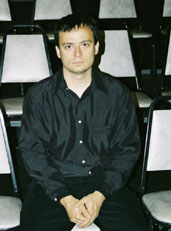
Rusty Banks is a composer/guitarist/teacher originally from Jasper, AL, now living in Pennsylvania.
His compositions benefit from themes relating to regions or environments. For example, his composition commissioned by the Alabama Music Teacher Association's 2004 convention featured audio samples from the Cahaba River, Alabama's last free-flowing river. Another work, "Long Pine Creek: New Year's Day," uses sounds from Long Pine Creek in Nebraska. His compositions range from traditional concert music to sonic installations where boom boxes are scattered throughout a room. His music is described as thoroughly modern, yet accessible, a description he shudders at, but reluctantly accepts. His compositions may be heard on Living Artist Recordings, as well as his web site, rustybanks.org.
|

Tuesday, December 12, 2006
Building a Better Music Appreciation Class
I occasionally find myself hired to teach what is essentially a Music Appreciation class. This year Iím teaching a 200-seat version of the beast called ďMusic and CultureĒ at Millersville University in Millersville, PA.
Iím always trying to sharpen how effective the class is at increasing awareness of (so-called) art music as well as increasing the studentsí ability to listen with depth and concentration.
This year Iím approaching the class from something closer to my interests. The class will deal with music and its relation to other arts, and its relation with technology. The first work to be studied will be Louie Andriessenís Racconto dallíInferno. This provides an opportunity to discuss modernism, tradition, literature, iTunes, and politics. Wow. From there we will process in a roughly reverse-chronological fashion, taking a more topical, rather than historical, approach.
Some other novel things:
1. No text. Each student will have an iTunes account and will purchase about $50 worth of music. Quite a steal compared to a music appreciation text. Iím also thrilled that the L.A. Phil and other organizations will have a 100-200 hit spike in their digital sales. Just think if there were 10 class like this across the country!
2. Examples of visual art as parallels (a staple in such courses) will come from regional art museums like the Philadelphia Museum of Art rather than, say, the Louvre. For that handful of students who really want to experience the material more fully, the opportunity will exist.
3. The class will be blogged on S21. The class topics will get a brief summary in my blog-space here, and extra-credit will be given to thoughtful comments. In a 200-seat class, discussion is more likely to occur this way.
4. Emphasis will shift away from common practice period music. Iíve always found it odd that the two most stylized eras, Baroque and Classical, often receive more class meetings that 1900 Ė The Present. Since there is a greater scope of style in music after WWII, shouldnít there be more time spent on it? Baroque, Classical, and Romantic music will receive a few classes each, at the most. Most of the class will deal with music after Debussy.
If anyone here has tried such things in a class as such, Iíd love to hear about it. Iím also open to suggestions/reflections anyone has on this subject.
posted by Rusty Banks
|
| |



